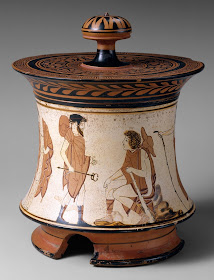This small vase -- it is less than seven inches tall with
its lid and less than five without it -- is a pyxis (pl. pyxides), a round
lidded container for cosmetics and jewelry. The pyxis was an everyday container
for Greek women. It was also associated with weddings. Pyxides were among the
presents brought to the bride were amphoriskoi (tiny amphorae for perfumed oil),
epinetra (knee protectors for carding wool), and lekythoi (oil bottles), as
well as loutrophoroi (large pots for the bridal bath). Many of these vases also
bore images relating to marriage in some way.
Our vase depicts the Judgment of Paris, certainly a subject
relating to marriage and indeed one of the most popular in Greek, Etruscan, and
Roman art. For example, we have hundreds of black-figure and red-figure vases
that depict it, and twenty-one Roman wall paintings, most from Pompeii.
The story was widely known. At the wedding of Peleus and
Thetis, an apple bearing the inscription TO THE FAIREST is tossed into the
midst of the guests. When the three goddesses Hera, Athena, and Aprhodite each
claim the title, Zeus tells Hermes to take them to Mt Ida near Troy, where the
shepherd Paris, a son of Priam, will decide which was the most beautiful. Each
of the goddesses offers Paris a bribe -- Hera promises him worldy power, Athena
victory in battle, and Aphrodite the loveliest woman in the world - Helen of
Sparta. Paris, ever the voluptuary, chooses Helen, and thus begins the Trojan
War.
The vase shows Paris as a beardless youth sitting on a rock,
not in Asiatic dress but in ordinary traveler’s gear: broad-brimmed hat
(petasos) hanging down his back from a cord, short cloak (chlamys), tall laced
sandals over stockings, and knotted club. Behind him is a bearded man wrapped
in a long mantle (himation) and holding a tall staff. He may be Priam, as the
great expert Sir John Beazley suggested, but there is no way of telling. Paris
is looking up at Hermes, easily recognized by his wand (kerykeion), dressed in
chlamys, petasos, and winged boots.
What is going on between Paris and Hermes? What moment in the
story is depicted? One idea is that Hermes has just arrived to give Paris Zeus’s
orders (as Richter thought). Another is that Paris has already received his
orders and is trying to make up his mind (Schefold).
Behind Hermes are the three goddesses. Hera, wearing chiton,
veil, and diadem, stands holding her scepter. Facing her is Athena in peplos and aegis,
holding a spear; she has taken off her helmet and put on a diadem.
Behind Athena stands Aphrodite wearing a chiton, himation,
and diadem; with her left hand she adjusts her himation and with her right she
holds a metal phiale or else an exaleiptron filled with perfume.
The technique is white-ground, with figures are drawn in
black outline and a variety of ceramic colors, especially for the garments.
The
piece is attributed to the Penthesilea Painter and its date is ca. 470 BC.
- Richter, Gisela M. A., “White Athenian Pyxis,” The Metropolitan Museum of Art Bulletin 3 (1908) 154-155.
- Richter, Gisela M. A. and Lindsley F. Hall, Red-Figured Athenian Vases in the Metropolitan Museum, Vol, 1 (1936) 101-103.
- Schefold, Karl and Franz Jung, Die Sagen von den Argonauten, von Theben und Troia in der klassischen und hellenistischen Kunst (1989) 104.




No comments:
Post a Comment